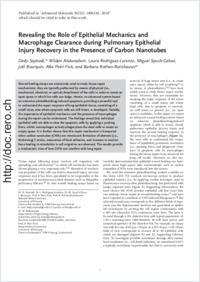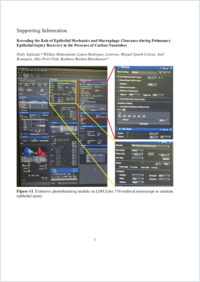Revealing the role of epithelial mechanics and macrophage clearance during pulmonary epithelial injury recovery in the presence of carbon nanotubes
- Septiadi, Dedy Adolphe Merkle Institute, University of Fribourg, Switzerland
- Abdussalam, Wildan Department of High Energy Density, Helmholtz-Zentrum Dresden-Rossendorf, Dresden, Germany
- Rodriguez‐Lorenzo, Laura Adolphe Merkle Institute, University of Fribourg, Switzerland
- Spuch‐Calvar, Miguel Adolphe Merkle Institute, University of Fribourg, Switzerland
- Bourquin, Joël Adolphe Merkle Institute, University of Fribourg, Switzerland
- Petri-Fink, Alke Department of Chemistry, University of Fribourg, Switzerland - Adolphe Merkle Institute, University of Fribourg, Switzerland
- Rothen-Rutishauser, Barbara Adolphe Merkle Institute, University of Fribourg, Switzerland
-
2018
Published in:
- Advanced Materials. - 2018, vol. 30, no. 52, p. 1806181
English
Wound healing assays are extensively used to study tissue repair mechanisms; they are typically performed by means of physical (i.e., mechanical, electrical, or optical) detachment of the cells in order to create an open space in which live cells can lodge. Herein, an advanced system based on extensive photobleaching‐induced apoptosis; providing a powerful tool to understand the repair response of lung epithelial tissue, consisting of a small injury area where apoptotic cells are still intact, is developed. Notably, the importance of epithelial mechanics and the presence of macrophages during the repair can be understood. The findings reveal that individual epithelial cells are able to clear the apoptotic cells by applying a pushing force, whilst macrophages actively phagocytose the dead cells to create an empty space. It is further shown that this repair mechanism is hampered when carbon nanotubes (CNTs) are introduced: formation of aberrant (i.e., thickening) F‐actins, maturation of focal adhesion, and increase in traction force leading to retardation in cell migration are observed. The results provide a mechanistic view of how CNTs can interfere with lung repair.
- Faculty
- Faculté des sciences et de médecine
- Department
- Département de Chimie
- Language
-
- English
- Classification
- Chemistry
- License
-
License undefined
- Identifiers
-
- RERO DOC 323822
- DOI 10.1002/adma.201806181
- Persistent URL
- https://folia.unifr.ch/unifr/documents/307388
Other files
Statistics
Document views: 124
File downloads:
- pdf: 234
- Supplementary material: 211

